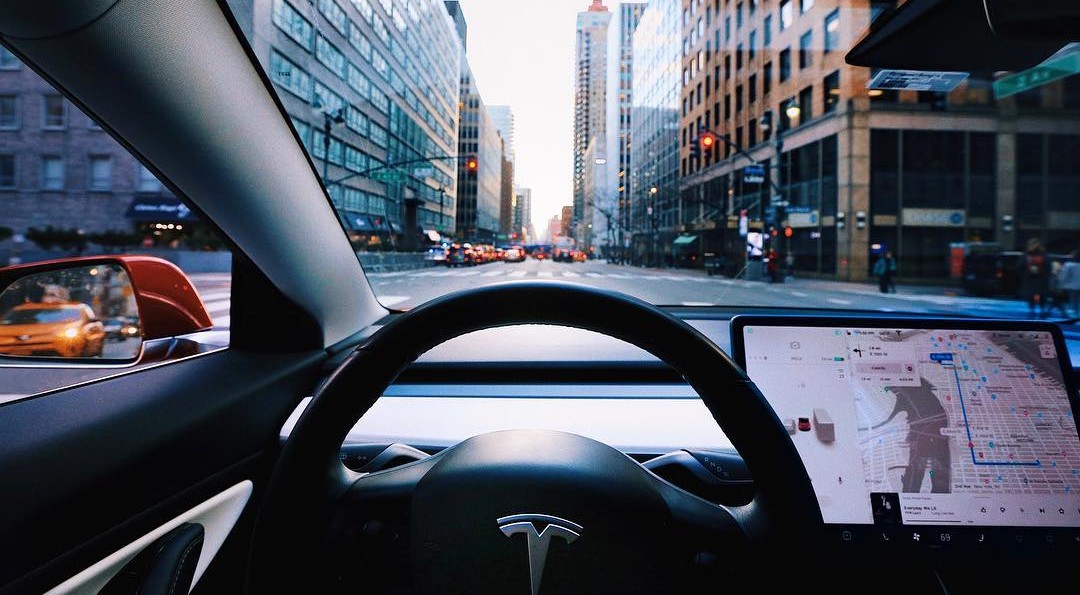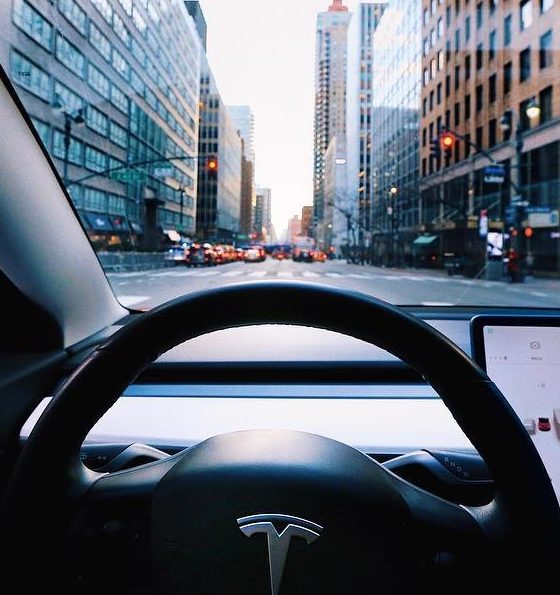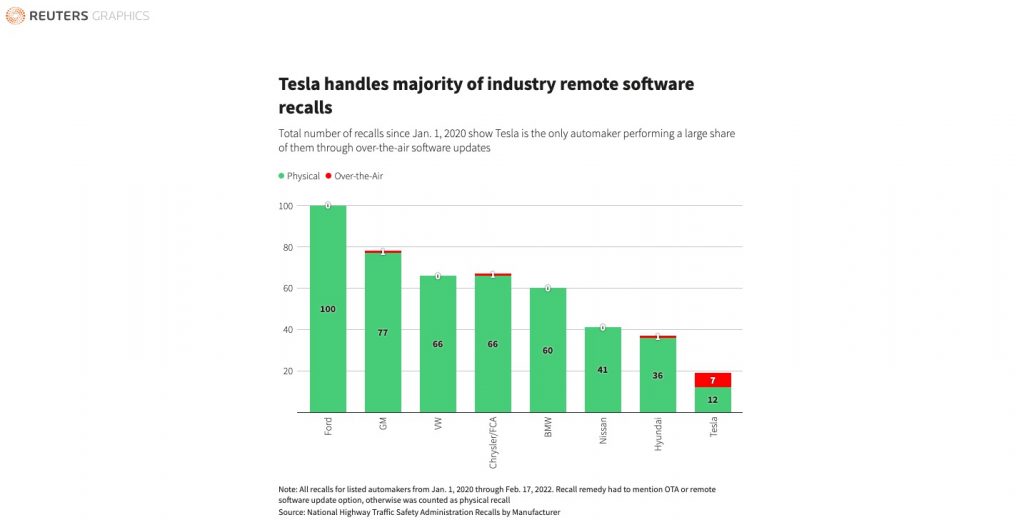

News
Tesla’s software fixes, the NHTSA’s status quo, and an impending need for updated recall terminologies
It is no secret that Tesla is a popular topic, so much so that the coverage around the company is immense. Couple this with CEO Elon Musk’s rockstar persona and you get a company whose vehicles are looked at under a microscope constantly. It might feel unfair for some, but it’s just the way it is. Tesla — by simply being Tesla — is newsworthy.
Tesla’s newsworthiness is a double-edged sword. A look at the coverage for the company’s vehicle recalls from the NHTSA would prove this point. So notable is Tesla’s news coverage that a mainstream newsreader would likely get the impression that Teslas get recalls frequently. The opposite is true. As evidenced by Reuters in the graphic below, data from January 1, 2020, through February 17, 2022, shows that Tesla actually recalls its vehicles less frequently than some of the market’s leading automakers. Tesla is also the only carmaker performing a large share of its vehicle recalls through over-the-air software updates.

Tesla currently handles the majority of the industry’s remote software recalls, but it would soon not be the only one. New electric vehicle makers have used the idea of software updates as a means to promote their EVs’ capabilities. Rivian has performed OTA updates to its R1 vehicles, and those cars are only starting customer deliveries. Lucid is the same with its Air sedan, with the company rolling out features like Automatic Emergency Braking, Cross-Traffic Protection, Lane Departure Protection, Traffic Drive-Off Alert, and other features earlier this month through a software update. Ford has been rolling out updates called “Power-Ups” to the Mustang Mach-E as well.
Considering that software-based fixes are only bound to get more widespread over the coming years, one must then ask the question: Should software-based over-the-air fixes be dubbed and classified with the same terminologies as physical recalls, which typically involve the replacement of vehicle hardware?
A Vastly Different “Recall” Experience
Any car owner has likely experienced a recall for their vehicle at some point in their driving life. And more likely than not, one’s experience is probably not that pleasant. I certainly count myself among drivers who look at vehicle recalls with trepidation. My current vehicle, a Japanese-made van, was part of a minor fuel pump recall a couple of years ago, and even addressing that took a whole day out of my weekend. The dealer was overwhelmed with the number of cars it was fixing that day, and tempers among owners were flaring by the hour — all for a simple fuel pump replacement. I’ve been told that my experiences with vehicle recalls are not that unique.
In comparison, a software-based fix, such as the disabling of FSD Beta’s “rolling stops” feature, only required affected vehicles to be connected to the internet. There was no dealer visit, no forms to fill out, and no staff to argue with. The car was connected to the internet, a software fix was implemented, and the issue was resolved. One can argue that Tesla’s software fix to disable FSD Beta’s “rolling stops” feature was safety-related, and that’s true. But one could also argue that at least from a driver’s point of view, the experience related to software and hardware-based recalls is vastly different.
The Status Quo
Despite the different experiences involved when software and hardware-based vehicle recalls are addressed, it appears that the National Highway Traffic Safety Administration (NHTSA) will, at least for now, keep the status quo. Teslarati reached out to the NHTSA to inquire if it was considering the adoption of updated terminologies for cars whose fixes are completed through OTA software updates, but the agency suggested that this would likely not be the case, at least for now. According to the NHTSA, vehicle manufacturers must initiate a recall for any repair that remedies a safety risk, regardless of whether the issue is fixed by software update or by hardware replacement.
“The National Highway Traffic Safety Administration is committed to ensuring the highest safety standards on the nation’s roadways. NHTSA is empowered with robust tools and authorities to protect the public, to investigate potential safety issues, and to compel recalls when it finds evidence of noncompliance or an unreasonable risk to safety. Manufacturers are required to initiate a recall for any repair, including a software update, that remedies an unreasonable risk to safety. NHTSA recalls can include any required repair, which includes a software update, to remedy a potential safety risk. Manufacturers are also required to submit any communications to owners, dealers, and others about any software updates that address a defect, whether it is safety-related or not,” the NHTSA stated.
Product recall specialist and associate professor at the Indiana University Kelley School of Business Professor George Ball told Teslarati that while the NHTSA’s use of similar terminologies for software and hardware-based recalls is “definitely an example of regulators and industry moving at a different pace on technology,” the agency’s hesitation in adopting new terminologies for OTA fixes is understandable. Professor Ball further explained that using terms such as “soft recall” to refer to software-based vehicle fixes might imply a reduced level of risk, and this is something that the NHTSA would likely be unwilling to do.
“I believe NHTSA would resist ‘soft recall’ terminology because it implies a reduced level of customer hazard and allows the firm to be under less scrutiny by the press and public for quality corrections. While some updates are minor, some of the Tesla software upgrades are actually quite serious, and if not done, can allow a harmful defect to persist,” the recall specialist said.
But while the NHTSA’s stance on recall terminologies is completely understandable, one cannot deny the fact that the issues covered by vehicle recalls have a very wide range of risks. Take Tesla’s recall for 817,143 vehicles, which was announced earlier this month, for example. The recall was initiated since a software error may prevent a warning chime from activating even if drivers do not have their seat belts on. From a layman’s perspective, this recall seems grave as it affects over 800,000 Teslas on the road today. However, the issue was simply addressed through firmware release 2021.43.101.1 and later, which included a remedy for the seat belt chime error.
Compare this with General Motors’ recall last year of 400,000 pickup trucks in the US. Granted, it only affected about half as many vehicles as Tesla’s seat belt chime recall, but its hardware-based nature suggested that the risk presented by the issue was great. The recall covered certain 2015 and 2016 Chevrolet and GMC Sierra 1500, 2500, and 3500 trucks, and it involved a faulty airbag inflator that may rupture without warning. To fix the issue, owners of the affected trucks were required to head to a dealer so that they could get their airbag modules replaced. Since parts were in short supply last year, however, owners were notified with a letter to inform them when their trucks’ replacement parts were available.
What Can Be Done
While the NHTSA will likely continue to maintain the status quo with its recall terminologies for the foreseeable future, Professor Ball told Teslarati that the agency can actually implement some adjustments now that can make distinguishing safety fixes and issues clearer. This would likely be extremely important in the near future as more connected cars are rolled out and software updates become the norm.
“If I were to provide advice to the NHTSA, I would recommend that they get out ahead of this issue before every car maker starts updating cars like Tesla. One way to do it is to require the automaker to send all auto updates to NHTSA when pushed out, and to classify updates as ‘minor’ or ‘major.’ Any major update that impacts customer safety would be classified as a recall. Automakers won’t like this, but it will help keep the safety fixes transparent for all, especially consumers. By sending all updates to NHSTA, the agency could assign qualified people to audit the classifications assigned by the manufacturer, to ensure they are making good decisions there.
“I think any language that de-emphasizes the importance of a safety recall is not likely to be supported by NHTSA, and it doesn’t likely help customer safety. A clear distinction needs to be made between minor updates and major updates that influence safety. Those major updates should be classified as a recall, and NHTSA needs to get their arms around these updates and keep on top of them soon, or they will fall way behind the industry,” the recall specialist said.
Recalls can affect the perception of a company to the public. Software fixes should be one of the factors that are considered an edge for automakers like Tesla, not the other way around. Gary Black, Managing Partner of The Future Fund LLC, explained this from the point of view of a Tesla investor. “Since every NHTSA recall so far has been quickly solvable via Tesla OTA updates, ‘recalls’ are noise to most investors. Tesla’s huge software edge highlights one of the key advantages of owning Tesla over every other EV manufacturer,” the Wall Street veteran told Teslarati.
OTA updates, including those related to vehicle safety, are coming. With automakers like Ford joining the group of carmakers embracing OTA updates, software-based fixes are inevitable. Ultimately, I am inclined to agree with the recall specialist. By refusing to adapt to the advent of software-based vehicle fixes, the NHTSA may risk being left behind by the automotive industry. And that’s a scenario that I believe no automaker — or government agency for that matter — would prefer.
Don’t hesitate to contact us with news tips. Just send a message to simon@teslarati.com to give us a heads up.

Elon Musk
Starlink passes 9 million active customers just weeks after hitting 8 million
The milestone highlights the accelerating growth of Starlink, which has now been adding over 20,000 new users per day.

SpaceX’s Starlink satellite internet service has continued its rapid global expansion, surpassing 9 million active customers just weeks after crossing the 8 million mark.
The milestone highlights the accelerating growth of Starlink, which has now been adding over 20,000 new users per day.
9 million customers
In a post on X, SpaceX stated that Starlink now serves over 9 million active users across 155 countries, territories, and markets. The company reached 8 million customers in early November, meaning it added roughly 1 million subscribers in under seven weeks, or about 21,275 new users on average per day.
“Starlink is connecting more than 9M active customers with high-speed internet across 155 countries, territories, and many other markets,” Starlink wrote in a post on its official X account. SpaceX President Gwynne Shotwell also celebrated the milestone on X. “A huge thank you to all of our customers and congrats to the Starlink team for such an incredible product,” she wrote.
That growth rate reflects both rising demand for broadband in underserved regions and Starlink’s expanding satellite constellation, which now includes more than 9,000 low-Earth-orbit satellites designed to deliver high-speed, low-latency internet worldwide.
Starlink’s momentum
Starlink’s momentum has been building up. SpaceX reported 4.6 million Starlink customers in December 2024, followed by 7 million by August 2025, and 8 million customers in November. Independent data also suggests Starlink usage is rising sharply, with Cloudflare reporting that global web traffic from Starlink users more than doubled in 2025, as noted in an Insider report.
Starlink’s momentum is increasingly tied to SpaceX’s broader financial outlook. Elon Musk has said the satellite network is “by far” the company’s largest revenue driver, and reports suggest SpaceX may be positioning itself for an initial public offering as soon as next year, with valuations estimated as high as $1.5 trillion. Musk has also suggested in the past that Starlink could have its own IPO in the future.
News
NVIDIA Director of Robotics: Tesla FSD v14 is the first AI to pass the “Physical Turing Test”
After testing FSD v14, Fan stated that his experience with FSD felt magical at first, but it soon started to feel like a routine.

NVIDIA Director of Robotics Jim Fan has praised Tesla’s Full Self-Driving (Supervised) v14 as the first AI to pass what he described as a “Physical Turing Test.”
After testing FSD v14, Fan stated that his experience with FSD felt magical at first, but it soon started to feel like a routine. And just like smartphones today, removing it now would “actively hurt.”
Jim Fan’s hands-on FSD v14 impressions
Fan, a leading researcher in embodied AI who is currently solving Physical AI at NVIDIA and spearheading the company’s Project GR00T initiative, noted that he actually was late to the Tesla game. He was, however, one of the first to try out FSD v14.
“I was very late to own a Tesla but among the earliest to try out FSD v14. It’s perhaps the first time I experience an AI that passes the Physical Turing Test: after a long day at work, you press a button, lay back, and couldn’t tell if a neural net or a human drove you home,” Fan wrote in a post on X.
Fan added: “Despite knowing exactly how robot learning works, I still find it magical watching the steering wheel turn by itself. First it feels surreal, next it becomes routine. Then, like the smartphone, taking it away actively hurts. This is how humanity gets rewired and glued to god-like technologies.”
The Physical Turing Test
The original Turing Test was conceived by Alan Turing in 1950, and it was aimed at determining if a machine could exhibit behavior that is equivalent to or indistinguishable from a human. By focusing on text-based conversations, the original Turing Test set a high bar for natural language processing and machine learning.
This test has been passed by today’s large language models. However, the capability to converse in a humanlike manner is a completely different challenge from performing real-world problem-solving or physical interactions. Thus, Fan introduced the Physical Turing Test, which challenges AI systems to demonstrate intelligence through physical actions.
Based on Fan’s comments, Tesla has demonstrated these intelligent physical actions with FSD v14. Elon Musk agreed with the NVIDIA executive, stating in a post on X that with FSD v14, “you can sense the sentience maturing.” Musk also praised Tesla AI, calling it the best “real-world AI” today.
News
Tesla AI team burns the Christmas midnight oil by releasing FSD v14.2.2.1
The update was released just a day after FSD v14.2.2 started rolling out to customers.

Tesla is burning the midnight oil this Christmas, with the Tesla AI team quietly rolling out Full Self-Driving (Supervised) v14.2.2.1 just a day after FSD v14.2.2 started rolling out to customers.
Tesla owner shares insights on FSD v14.2.2.1
Longtime Tesla owner and FSD tester @BLKMDL3 shared some insights following several drives with FSD v14.2.2.1 in rainy Los Angeles conditions with standing water and faded lane lines. He reported zero steering hesitation or stutter, confident lane changes, and maneuvers executed with precision that evoked the performance of Tesla’s driverless Robotaxis in Austin.
Parking performance impressed, with most spots nailed perfectly, including tight, sharp turns, in single attempts without shaky steering. One minor offset happened only due to another vehicle that was parked over the line, which FSD accommodated by a few extra inches. In rain that typically erases road markings, FSD visualized lanes and turn lines better than humans, positioning itself flawlessly when entering new streets as well.
“Took it up a dark, wet, and twisty canyon road up and down the hill tonight and it went very well as to be expected. Stayed centered in the lane, kept speed well and gives a confidence inspiring steering feel where it handles these curvy roads better than the majority of human drivers,” the Tesla owner wrote in a post on X.
Tesla’s FSD v14.2.2 update
Just a day before FSD v14.2.2.1’s release, Tesla rolled out FSD v14.2.2, which was focused on smoother real-world performance, better obstacle awareness, and precise end-of-trip routing. According to the update’s release notes, FSD v14.2.2 upgrades the vision encoder neural network with higher resolution features, enhancing detection of emergency vehicles, road obstacles, and human gestures.
New Arrival Options also allowed users to select preferred drop-off styles, such as Parking Lot, Street, Driveway, Parking Garage, or Curbside, with the navigation pin automatically adjusting to the ideal spot. Other refinements include pulling over for emergency vehicles, real-time vision-based detours for blocked roads, improved gate and debris handling, and Speed Profiles for customized driving styles.








